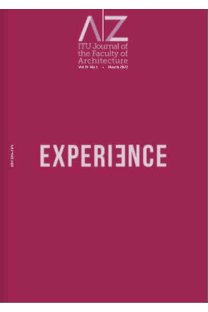From rigidity to ephemerality: Architecture as a socio-spatial assemblage of heterogeneous components
___
Amborst, T., D’Orca, D., & Theodore, G. (2016). Architecture takes time. In H. Castle & K. A. Frank (Eds.), Architecture timed: designing with time in mind (pp. 108-113). London: John Wiley & Sons.Anderson, B., Kearnes, M., Mc- Farlane, C., & Swanton, D. (2012). On Assemblages and Geography. Dialogues in Human Geography, 2(2) 171-189, https://doi. org/10.1177/2043820612449261
Bonnemaison, S., & Macy, C., eds. (2008). Festival Architecture. London, England: Routledge.
Cohen, D., & Crabtree, B. (2006, July). Qualitative Research Guidelines Project. Retrieved from http://www. qualres.org/HomeSemi-3629.html
DeLanda, M. (2006). A New Philosophy of Society: Assemblage Theory and Social Complexity. London, England: Continuum.
Delbeke, M. (2008). Framing history: The Jubilee of 1625, the dedication of new Saint Peter’s and the Baldacchino. In S. Bonnemaison & C. Macy (Eds.), Festival Architecture (pp. 129- 154). London, England: Routledge.
Deleuze, G., & Guattari, F. (1987). A Thousand Plateaus: Capitalism and Schizophrenia (B. Massumi, Trans). Minneapolis, MN: University of Minnesota Press. (Original work published 1980).
Dovey, K., Wood, S. (2015). Public/ private urban interfaces: type, adaptation, assemblage. Journal of Urbanism: International Research on Placemaking and Urban Sustainability, 8(1) 1-16. https://doi.org/10.1080/17549175.201 4.891151
Edwards, R., & Holland, J. (2013). What is qualitative interviewing? London, England: Bloomsbury.
Frank, K. A. (2016). Designing with Time in Mind [Introduction]. In H. Castle & K. A. Frank (Eds.), Architecture timed: designing with time in mind (pp. 8-17). West Sussex, England: John Wiley & Sons, Inc.
Getz, D. (2007). Event Studies: Theory, Research and Policy for Planned Events. Oxford: Butterworth‐Heinemann.
Golafshani, N. (2003). Understanding Reliability and Validity in Qualitative Research. The Qualitative Report, 8(4), 597-606. Retrieved from http:// nsuworks.nova.edu/tqr/vol8/iss4/6
Harris, O. J.T. (2016). Affective architecture in Ardnamurchan: assemblages at three scales. In M. Bille & T. F. Sørensen (Eds.), Elements of architecture: assembling archaeology, atmosphere and the performance of building spaces (pp. 195-212). London, England: Routledge.
Haque, U. (2004). The Choreography of Sensations: Three Case Studies of Responsive Environment Interface. Retrieved from https://www.haque. co.uk/papers/choreography-of-sensations. pdf
Karandinou, A. (2013). No Matter: Theories and Practices of the Ephemeral in Architecture. (C. Eamonn, Ed.). Farnham, Surrey: Ashgate.
Kennedy, R., Zapasnik, J., McCann, H., & Bruce, M. (2013). All those little machines: Assemblage as transformative theory. Australian Humanities Review, (55) 45-66.
Lifschutz, A. (2017). Long Life, Loose Fit, Low Energy [Introduction]. In A. Lifschutz (Ed.), Loose-fit architecture: designing buildings for change (pp. 6-17). West Sussex, England: John Wiley & Sons.
Matthews, D. (2008). Special Event Production: The Process. Oxford, England: Butterworth–Heinemann.
Mcfarlane, C. (2011). The city as assemblage: Dwelling and urban space. Environment and Planning D: Society and Space, 29(4) 649-671. https://doi. org/10.1068/d4710
Mehrotra, R., & Vera, F. (2015). Reversibility: Disassembling the biggest ephemeral mega city. ARQ (Santiago), (90) 14-25. http://dx.doi.org/10.4067/ S0717-69962015000200003
Müller, M. (2015). Assemblages and Actor–networks: Rethinking Socio- material Power, Politics and Space. Geography Compass, 9, 27-41. https:// doi.org/10.1111/gec3.12192
Murray, P., & Brand, S. (2017). Learning from the West Coast: Long-Termism and Change. In A. Lifschutz (Ed.), Loose-fit architecture: designing buildings for change (pp. 24-29). West Sussex, England: John Wiley & Sons.
Monin, E. (2003). The Construction of Fantasy: Ephemeral Structures and Urban Celebrations in France during The Eighteenth Century. In F. S. Huerta (eds.), Proceedings of the First International Congress on Construction History: Madrid, 20th-24th January 2003, (3) 1475-1487, ISBN: 84-9728-073-3. https://dialnet.unirioja.es/servlet/articulo? codigo=4186498
Pallasmaa, J. (2014). Space, place and atmosphere. Emotion and peripherical perception in architectural experience. Lebenswelt: Aesthetics and Philosophy of Experience, (4) 230-245. https://doi. org/10.13130/2240-9599/4202
Partridge, E. (1966). Origins: An Etymological Dictionary of Modern English. London, England: Routledge.
Tschumi, B. (1994). Architecture and Disjunction. Cambridge, MA: MIT Press.
- ISSN: 2564-7474
- Yayın Aralığı: 3
- Başlangıç: 2005
- Yayıncı: İTÜ Rektörlüğü
Documentation and mapping of underwater cultural landscapes case study: Ancient Lycia - Kaş
Sinem GÜREVİN, Yasin Çağatay SEÇKİN
Imene SELKA OUSSADIT, Chihab SELKA, Mohammed Nabil OUISSI, Olivier BOUET
The effects of interaction and learning styles on children’s experiences in exhibition spaces
Seniye Banu GARİP, Gökçe EVREN
Ferro YUDISTIRA, Yandi Andri YATMO, Paramita ATMODIWIRJO
Haniye RAZAVIVAND FARD, Yüksel DEMİR, Marco TRISCIUOGLIO
Sema MUMCU, Serap YILMAZ, Duygu AKYOL
Residents’ experiences of a gentrified neighborhood in Istanbul: The case of Akaretler row houses
Mehmet RONAEL, Gülden Demet ORUÇ
Case issues and data on houses in the 17th century Istanbul Kadı registers
Architectonics as synthesis of architectural and engineering disciplines
Natalia Vladimirovna NORİNA, Veniamin Aleksandrovich NORİN, Yuriy Vladimirovich PUKHARENKO
